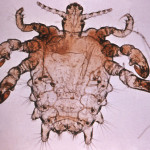
Pubic lice are tiny, round, wingless insects that live on the skin. They’re also called crabs because they have “claws,” which they use to hang on to hair. They’re light brown and the size of a pinhead. Pubic lice feed on the blood of a human; however, they can live up to 24 hours away from the person. Crabs infect hairy parts of the body, especially around the pubic area but they can also be found in eyebrow, armpit, mustache, or beard hair. They can be very hard to see because they are tiny. If you do see them, you will notice they look like small scabs. A female louse can lay up to 26 eggs (also called nits) over 3-4 weeks’ time. The eggs then take about 8 days to hatch. The nits look like little white dots that are close to the hair root.
Am I at risk for getting pubic lice?
Anyone can get pubic lice. However, pubic lice are usually spread by sexual contact. People with more sex partners have a greater risk of getting infected with pubic lice.
What are the signs and symptoms of pubic lice?
If you have pubic lice, you may not have any symptoms. If you do get symptoms, they usually start 5 days to several weeks after getting the lice. You may get lots of itching around your pubic hair or genital area. The itching is because of an allergic reaction to the bites. If you scratch a lot, you’re putting yourself at risk of getting a skin infection.
How are pubic lice diagnosed?
Pubic lice are diagnosed by a health care provider who can carefully look at the infected area and prescribe medicine. It’s important to see your health care provider because pubic lice can be confused with other skin problems. Also, you should be tested for other sexually transmitted infections.
How are pubic lice treated?
There are several options, both over the counter and prescription medications, for treatment that you can talk about with your health care provider. These include special creams, lotions, or shampoos that you can buy in a drug store, as well as prescription lice medicines. The most common treatments are: Permethrin (Nix®, Rid) and Pyrethrin (A-200, Pronto, Tisit)
Things to know about treatment include:
- Follow the directions that come with the medicine. Treatments may need to be applied more than once.
- You should not shave your pubic hair to remove the lice or (crabs).
- Apply the lotion or cream to the skin that is covered with hair.
- Even after you finish treatment, you could have itching for a while.
- If you scratch a lot, it may cause a skin infection.
- If you have sign(s) of an infection such as redness or swelling of the skin in your pubic area, you should see your health care provider.
How can I prevent spreading pubic lice?
If you have pubic lice:
- Avoid close body contact with others.
- Get treatment right away to prevent spreading them to others.
- Make sure you wash your clothes and bed sheets in hot water and dry them in a hot dryer. If you can’t wash them, either dry-clean them or place them in a sealed bag for 2 weeks.
- If you find out you have pubic lice or “crabs”, you’ll need to tell your sex partner(s) or anyone you have had close contact with or has shared your bed sheets, clothes, or towels. The Center for Disease Control (CDC) recommends that anyone with confirmed pubic lice should be treated and other people living in the same home should get checked. Some doctors may also prescribe treatment for those who are sleeping with someone with confirmed pubic lice.
How can I avoid getting pubic lice?
You are unlikely to get pubic lice if you do not have sexual contact. You have a much lower chance of getting pubic lice if you have only one sex partner. Condoms don’t protect from pubic lice. Try not to use other people’s clothing or bed sheets. If you think you have pubic lice, see your health care provider as soon as possible to get treated!
 Young Men's Health
Young Men's Health
